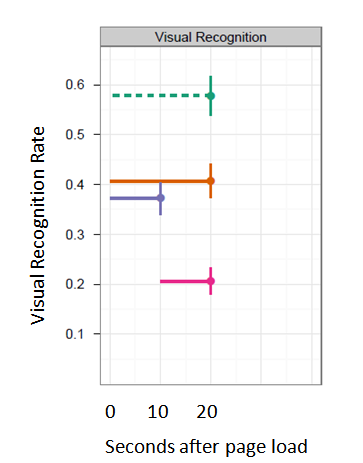Time-based internet advertising
USING TIME, IN ADDITION TO IMPRESSIONS, FOR INTERNET ADVERTISING

From Goldstein, Suri, McAfee (2011)
Last week it was announced that Facebook is rotating its ads after a certain time of exposure.
In 2011 and 2012, Sid Suri, Preston McAfee, and Dan Goldstein published a couple papers putting forth and improving the idea of time-based internet advertising:
- Goldstein, Daniel G., R. Preston McAfee, & Siddharth Suri. (2012). Improving the effectiveness of time-based display advertising. Proceedings of the 13th ACM Conference on Electronic Commerce (EC’12) [Winner: Best Paper Award]
- Goldstein, Daniel G., R. Preston McAfee, & Siddharth Suri. (2011). The effects of exposure time on memory of display advertisements. Proceedings of the 12th ACM Conference on Electronic Commerce (EC’11)
How does it work? Well, there are a couple primary forces at play. First, the longer an ad is in view, the more likely people are to remember it later. This can be seen in the graph above, based on an experiment in which the time an ad was in view was manipulated randomly. Second, ads that appear soon after the page loads are more likely to be remembered than ads that appear a longer time after the page loads. This can be seen below.

From Goldstein, Suri, McAfee (2012)
These data are based on an experiment in which an ad was made to appear during certain seconds after the page loaded.
The vertical axis shows the probability of recognizing an ad after the experiment. The horizontal axis shows the number of seconds that have elapsed after a page loads. For example, the short line running from 0 to 10 seconds shows the probability of recognition of an ad that was present for the first ten seconds after the page loaded. The short line running from 10 to 20 seconds shows the probability of recognition of an ad that was shown for the second 10 seconds after the page loaded. Clearly, the ad that was shown immediately after the page loads is more likely to be remembered. We hypothesize that people are visually scanning the page soon after it loads and that after a while, they start reading and do not notice ads anymore. (The vertical line segments are standard error bars)
The long line that hits the vertical axis at about .4 shows roughly the recognition rate you get by leaving an ad up for the first 20 seconds after the page loads. The line at top shows the recognition rate you get by advertising in the first 10 seconds on one page load and the second 10 seconds on another page load (the sum of the bottom two lines). This shows that two ten-second exposures are better than one 20-second exposure, even if one of the ten-second exposures takes place in the less desirable second slot (seconds 10 to 20 after the page loads). To learn more, check out Goldstein, Suri and McAfee (2012).
NEWS REFERENCES
Facebook now replacing ads on static pages
Facebook begins rotating ads on static pages if users don’t interact
** AMA MARKETING JOB MARKET NEWS **
Schools that are interviewing at the AMA and are interested in an excellent and computationally-skilled rookie should arrange to interview Yvetta Simonyan who is completing her PhD under myself and others at London Business School.



